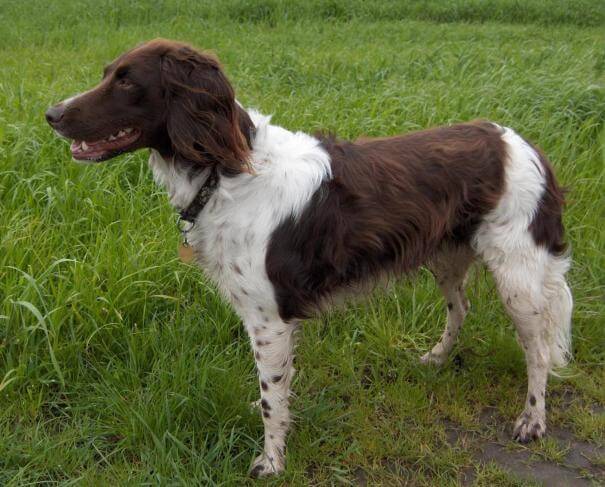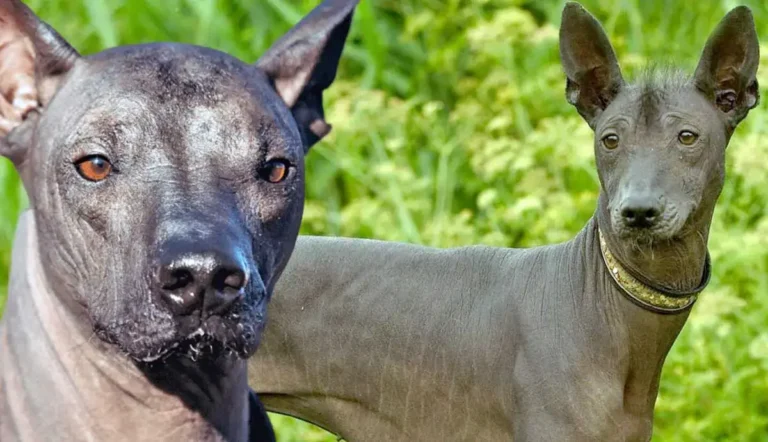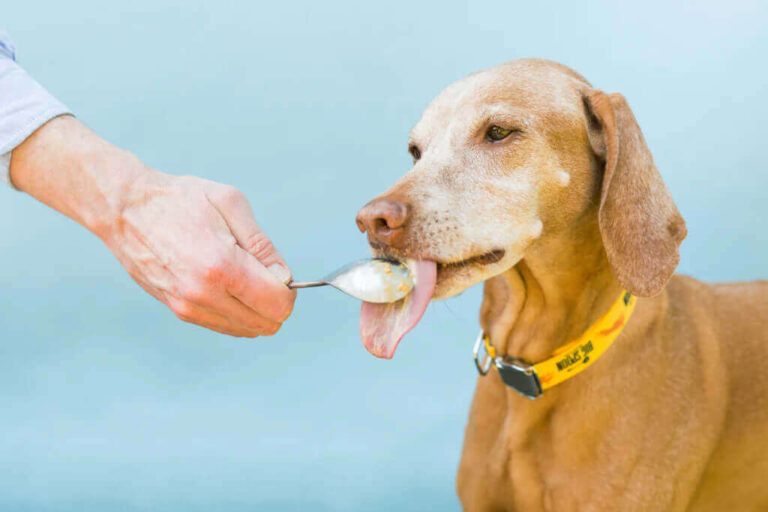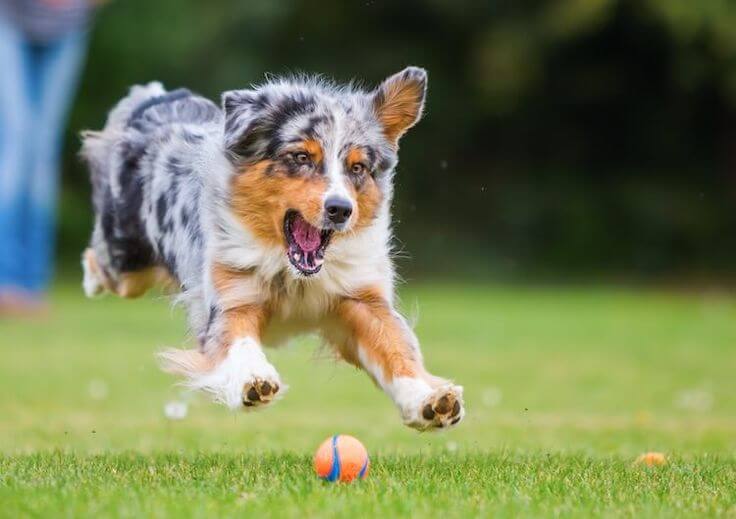Irish Red and White Setter Dog Breed: Traits, Care, and History
The Irish Red and White Setter is a breed that captures the heart with its striking appearance and endearing personality. Known for their athletic build, keen intelligence, and gentle nature, these dogs are not only beautiful but also incredibly functional as both family pets and hunting companions. The breed’s rich history and unique characteristics make them stand out among other gundogs, providing a perfect blend of form and function.
Contents
- 1 History and Origin
- 2 Physical Characteristics
- 3 Temperament and Personality
- 4 Training and Exercise Needs
- 5 Health and Lifespan
- 6 Diet and Nutrition
- 7 Grooming and Maintenance
- 8 Living Conditions
- 9 Breed Standards
- 10 Activities and Competitions
- 11 History and Origin
- 12 Physical Characteristics
- 13 Temperament and Personality
- 14 Training and Exercise Needs
- 15 Health and Lifespan
- 16 Diet and Nutrition
- 17 Grooming and Maintenance
- 18 Living Conditions
History and Origin
Early Beginnings in Ireland
The origins of the Irish Red and White Setter can be traced back to Ireland in the 17th century. Initially bred for hunting game birds, these dogs were prized for their ability to “set” or crouch low, signaling the presence of birds to hunters. This method was particularly effective before the widespread use of firearms, as hunters would use nets to capture the game.
Near Extinction and Revival
By the end of the 19th century, the breed faced near extinction due to the rising popularity of the solid-colored Irish Setters. It wasn’t until the early 20th century that a concerted effort by dedicated breeders, including the Reverend Noble Huston, helped revive the breed. Their efforts ensured the preservation of the Irish Red and White Setter’s unique traits and hunting abilities.
Recognition by Major Kennel Clubs
The Irish Red and White Setter gained official recognition from the American Kennel Club (AKC) in 2009. This acknowledgment marked an important milestone, validating the breed’s distinct identity and securing its place in the canine world.
Physical Characteristics
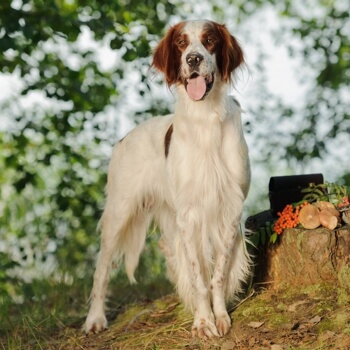
Size and Weight
The Irish Red and White Setter Dog is a medium to large-sized breed. Males typically stand between 24.5 to 26 inches at the shoulder and weigh around 42 to 60 pounds. Females are slightly smaller, standing between 22.5 to 24 inches and weighing 35 to 50 pounds. This size allows them to be agile and efficient in the field while maintaining a robust and sturdy build.
Coat and Colors
The breed is known for its beautiful, medium-length double coat that is predominantly white with solid red patches. This coloration not only adds to their striking appearance but also provides excellent camouflage in the hunting fields of Ireland. The coat is silky to the touch and requires regular grooming to maintain its condition.
Distinctive Features
Distinctive features of the Irish Red and White Setter include their expressive eyes, which convey intelligence and a friendly demeanor, and their feathered tail and legs, which add to their elegant appearance. Their well-proportioned body and graceful movements make them a sight to behold both in the field and at home.
Temperament and Personality
General Disposition
Irish Red and White Setters are known for their friendly, outgoing nature. They are affectionate with their families and tend to be gentle and patient with children. Their high energy levels make them playful and engaging companions, always ready for an adventure.
Interaction with Families and Children
These dogs are excellent family pets due to their loving and protective nature. They thrive on human interaction and are particularly good with children, making them ideal for active families. Their patience and gentle demeanor ensure they are safe and reliable companions.
Behavior with Other Pets
Irish Red and White Setters generally get along well with other dogs and can coexist peacefully with pets they are raised with. However, due to their strong hunting instincts, care should be taken when introducing them to smaller animals. Proper socialization from a young age can help mitigate any potential issues.
Training and Exercise Needs

Basic Training Tips
Training an Irish Red and White Setter requires consistency, patience, and positive reinforcement. These intelligent dogs respond well to gentle guidance and are eager to please their owners. Early socialization and basic obedience training are essential to help them develop into well-mannered adults.
Advanced Training for Hunting
For those interested in hunting, specialized training can enhance the dog’s natural abilities. Irish Red and White Setters excel in field trials and hunting competitions, where their keen sense of smell and instinctive setting behavior shine. Training should focus on reinforcing their pointing and retrieving skills.
Daily Exercise Requirements
These energetic dogs require plenty of daily exercise to stay healthy and happy. Long walks, runs, and play sessions are necessary to meet their physical needs. Engaging them in activities like fetch, agility training, or even swimming can provide both physical and mental stimulation.
Health and Lifespan
Common Health Issues
While generally healthy, Irish Red and White Setters can be prone to certain genetic conditions, including hip dysplasia, progressive retinal atrophy (PRA), and some autoimmune disorders. Regular veterinary check-ups and responsible breeding practices can help mitigate these risks.
Lifespan Expectancy
The average lifespan of an Irish Red and White Setter is around 11 to 15 years. Maintaining a healthy diet, regular exercise, and routine veterinary care are crucial for ensuring they live a long and healthy life.
Regular Health Check-ups and Maintenance
Regular health check-ups are essential for early detection and treatment of potential health issues. Routine vaccinations, dental care, and parasite prevention should be part of their regular health maintenance. Monitoring their weight and overall condition can also help prevent obesity-related problems.
Diet and Nutrition
Recommended Diet Plans
A balanced diet is key to the health and wellbeing of an Irish Red and White Setter. High-quality commercial dog food that meets their nutritional requirements is recommended. Depending on their age, size, and activity level, the diet should be adjusted accordingly.
Feeding Schedule and Portions
Feeding them twice a day, once in the morning and once in the evening, helps maintain their energy levels and prevent issues like bloat. Portion control is essential to avoid overfeeding and subsequent weight gain. Consulting with a veterinarian can help determine the appropriate portion sizes.
Supplements and Treats
Including supplements like omega-3 fatty acids can support their coat health and joint function. Treats should be given in moderation and should complement their overall diet, not replace balanced meals. Healthy treat options include fruits, vegetables, and specially formulated dog treats.
Grooming and Maintenance
Coat Care and Shedding
Regular brushing, at least two to three times a week, helps keep their coat free of tangles and matting. During shedding seasons, more frequent brushing may be required to manage loose hair. Bathing should be done as needed, typically every few months or when they get particularly dirty.
Bathing and Hygiene
Using a mild dog shampoo, bath time can help maintain their coat’s natural oils and keep their skin healthy. Regular ear cleaning, nail trimming, and dental hygiene are also important aspects of their overall grooming routine.
Nail Trimming and Dental Care
Nails should be trimmed regularly to prevent overgrowth and splitting. Daily or weekly brushing of their teeth can prevent tartar buildup and dental diseases. Providing dental chews and toys can also help maintain oral health.
Living Conditions
Ideal Home Environment
Irish Red and White Setters thrive in homes where they have plenty of space to move and play. They are not well-suited for apartment living unless they receive ample outdoor exercise. A home with a secure yard where they can run and explore is ideal.
Adaptability to Different Living Situations
While they prefer more space, these adaptable dogs can adjust to various living conditions as long as their exercise and mental stimulation needs are met. They can live in urban environments if provided with regular opportunities to exercise and engage with their surroundings.
Outdoor vs. Indoor Living
While they enjoy spending time outdoors, Irish Red and White Setters are also family-oriented dogs who want to be part of household activities. They should not be left outside for long periods and should have access to a comfortable indoor living space.
Breed Standards
American Kennel Club (AKC) Standards
According to the AKC, the Irish Red and White Setter should be balanced, graceful, and athletic with a coat that is primarily white with solid red patches. The breed standard emphasizes their hunting abilities, friendly disposition, and overall soundness.
The Kennel Club (UK) Standards
The Kennel Club in the UK describes the breed as possessing a noble and athletic appearance, with a strong build and graceful movement. The coat should be silky and straight, with distinctive red and white coloration. Temperament is noted as affectionate and trainable.
Differences in Breed Standards Globally
While breed standards are similar worldwide, slight differences may exist between organizations. These variations can include minor differences in size, coat texture, and specific markings allowed. However, the core characteristics and temperament remain consistent.
Activities and Competitions
Participation in Dog Shows
Irish Red and White Setters often participate in conformation shows where their physical attributes and adherence to breed standards are judged. These events highlight their beauty, grace, and adherence to breed standards.
Field Trials and Introduction to the Irish Red and White Setter Dog Breed
The Irish Red and White Setter is a captivating breed known for its striking appearance and amiable temperament. With a rich history, these dogs are celebrated for their hunting prowess and are cherished family companions. Their distinctive red and white coat and athletic build make them stand out in both fields and homes.
History and Origin
Early Beginnings in Ireland
The Irish Red and White Setter has its roots in 17th-century Ireland, where it was bred primarily for hunting game birds. The breed’s name comes from its unique “setting” behavior, where the dog would crouch low to signal the presence of birds to hunters, facilitating the use of nets before firearms became common.
Near Extinction and Revival
By the late 19th century, the breed faced a severe decline due to the rising popularity of the all-red Irish Setters. It was thanks to the efforts of dedicated breeders in the early 20th century, notably Reverend Noble Huston, that the breed was revived. Their commitment preserved the Irish Red and White Setter’s unique characteristics and ensured its survival.
Recognition by Major Kennel Clubs
The American Kennel Club (AKC) officially recognized the Irish Red and White Setter in 2009. This recognition marked a significant milestone, highlighting the breed’s distinct identity and securing its place in the canine community.
Physical Characteristics
Size and Weight
The Irish Red and White Setter is a medium to large-sized dog. Males typically stand 24.5 to 26 inches tall at the shoulder and weigh 42 to 60 pounds. Females are slightly smaller, standing 22.5 to 24 inches tall and weighing 35 to 50 pounds. This stature provides a perfect balance of strength and agility.
Coat and Colors
This breed is known for its beautiful, medium-length double coat, which is predominantly white with solid red patches. The coat is silky and smooth, requiring regular grooming to keep it in optimal condition. The distinctive coloration not only adds to their visual appeal but also serves as effective camouflage in the hunting fields.
Distinctive Features
Irish Red and White Setters have expressive eyes that exude intelligence and warmth, feathered tails, and legs that enhance their elegant appearance. Their well-proportioned bodies and graceful movements make them both functional hunters and strikingly beautiful dogs.
Temperament and Personality
General Disposition
These dogs are known for their friendly, outgoing nature. They are affectionate, gentle, and eager to please, making them excellent companions. Their playful and energetic disposition ensures they are always ready for an adventure.
Interaction with Families and Children
Irish Red and White Setters are ideal family pets. They are gentle and patient with children and form strong bonds with their human families. Their friendly and protective nature makes them reliable and loving companions for kids.
Behavior with Other Pets
Generally, these dogs get along well with other pets, especially if they are socialized from a young age. Their natural hunting instincts mean care should be taken when introducing them to smaller animals, but with proper training and socialization, they can coexist peacefully with other household pets.
Training and Exercise Needs
Basic Training Tips
Training should be consistent, positive, and gentle, as Irish Red and White Setters respond best to positive reinforcement. Early socialization and basic obedience training are crucial to developing a well-mannered and adaptable dog. They are intelligent and eager to learn, making them relatively easy to train.
Advanced Training for Hunting
For those interested in hunting, advanced training can enhance the breed’s natural abilities. Irish Red and White Setters excel in field trials and hunting competitions due to their keen sense of smell and instinctive setting behavior. Training should focus on honing their pointing and retrieving skills.
Daily Exercise Requirements
These dogs are highly energetic and require substantial daily exercise to stay healthy and happy. Long walks, runs, and interactive play sessions are essential. Engaging them in activities like fetch, agility training, or even swimming provides both physical and mental stimulation.
Health and Lifespan
Common Health Issues
While generally healthy, Irish Red and White Setters can be prone to certain genetic conditions such as hip dysplasia, progressive retinal atrophy (PRA), and some autoimmune disorders. Responsible breeding and regular veterinary check-ups can help manage these risks.
Lifespan Expectancy
The average lifespan of an Irish Red and White Setter is around 11 to 15 years. Maintaining a healthy diet, regular exercise, and routine veterinary care are crucial to ensuring a long and healthy life.
Regular Health Check-ups and Maintenance
Regular veterinary check-ups are essential for early detection and treatment of potential health issues. Routine vaccinations, dental care, and parasite prevention should be part of their regular health maintenance. Monitoring their weight and overall condition helps prevent obesity-related problems.
Diet and Nutrition
Recommended Diet Plans
A balanced diet is key to the health and wellbeing of an Irish Red and White Setter. High-quality commercial dog food that meets their nutritional requirements is recommended. Diet should be adjusted according to their age, size, and activity level.
Feeding Schedule and Portions
Feeding them twice a day, once in the morning and once in the evening, helps maintain their energy levels and prevent issues like bloat. Portion control is essential to avoid overfeeding and subsequent weight gain. Consulting with a veterinarian can help determine the appropriate portion sizes.
Supplements and Treats
Including supplements like omega-3 fatty acids can support their coat health and joint function. Treats should be given in moderation and should complement their overall diet, not replace balanced meals. Healthy treat options include fruits, vegetables, and specially formulated dog treats.
Grooming and Maintenance
Coat Care and Shedding
Regular brushing, at least two to three times a week, helps keep their coat free of tangles and matting. During shedding seasons, more frequent brushing may be required to manage loose hair. Bathing should be done as needed, typically every few months or when they get particularly dirty.
Bathing and Hygiene
Using a mild dog shampoo, bath time can help maintain their coat’s natural oils and keep their skin healthy. Regular ear cleaning, nail trimming, and dental hygiene are also important aspects of their overall grooming routine.
Nail Trimming and Dental Care
Nails should be trimmed regularly to prevent overgrowth and splitting. Daily or weekly brushing of their teeth can prevent tartar buildup and dental diseases. Providing dental chews and toys can also help maintain oral health.
Living Conditions
Ideal Home Environment
Irish Red and White Setters thrive in homes where they have plenty of space to move and play. They are not well-suited for apartment living unless they receive ample outdoor exercise. A home with a secure yard where they can run and explore is ideal.
Adaptability to Different Living Situations
While they prefer more space, these adaptable dogs can adjust to various living conditions as long as their exercise and mental stimulation needs are met. They can live in urban environments if provided with regular opportunities to exercise and engage with their surroundings.
Outdoor vs. Indoor Living
While they enjoy spending time outdoors, Irish Red and White Setters are also family-oriented dogs who want to be part of household activities. They should not be left outside for long periods and should have access to a comfortable indoor living space.
Conclusion
The Irish Red and White Setter is a remarkable breed with a rich history and a blend of physical beauty, intelligence, and amiable temperament. Their striking red and white coat, along with their graceful movements, makes them stand out both in the field and at home. Known for their friendly and outgoing nature, they make excellent family pets and are particularly good with children.
- Golden Retriever Pros and Cons: What Every Pet Parent Should Know - 15 September 2025
- Cane Corso Dog Breed: Health, Care, and Lifespan - 14 September 2025
- Catahoula Leopard Dogs: Description, Temperament, Lifespan, & Facts - 21 July 2025



